
The hanging man candlestick pattern is used when the market is bullish to identify signs of the market turning bearish.The hanging man is a bearish candlestick pattern that indicates a trend reversal. Each individual candlestick is constructed from four data points. The open, close, high, and low are them. These informational pieces help the knowledgeable trader understand the current state of the market.
The hanging man pattern is formed when the price opens higher than the previous day’s close but then drops significantly during the day, closing near or below the opening price. The pattern looks like a hanging man, hence the name.
A hanging man structure appearing after an uptrend is a reliable signal that the market trend may be about to reverse in the near future. Traders can use this information to help them make informed decisions about their investments and possibly avoid losses as a result.
What does a Hanging Man Candlestick indicate?
A Hanging Man candlestick is a technical analysis bearish reversal pattern that indicates a potential trend reversal from an uptrend to a downtrend. It forms at the top of an uptrend and has a small real body, a long lower shadow, and little to no upper shadow. The long lower shadow indicates that the price dropped significantly during the day but recovered and closed near the opening price, forming a small real body resembling a hanging man. Below is a picture of the the pattern formation.
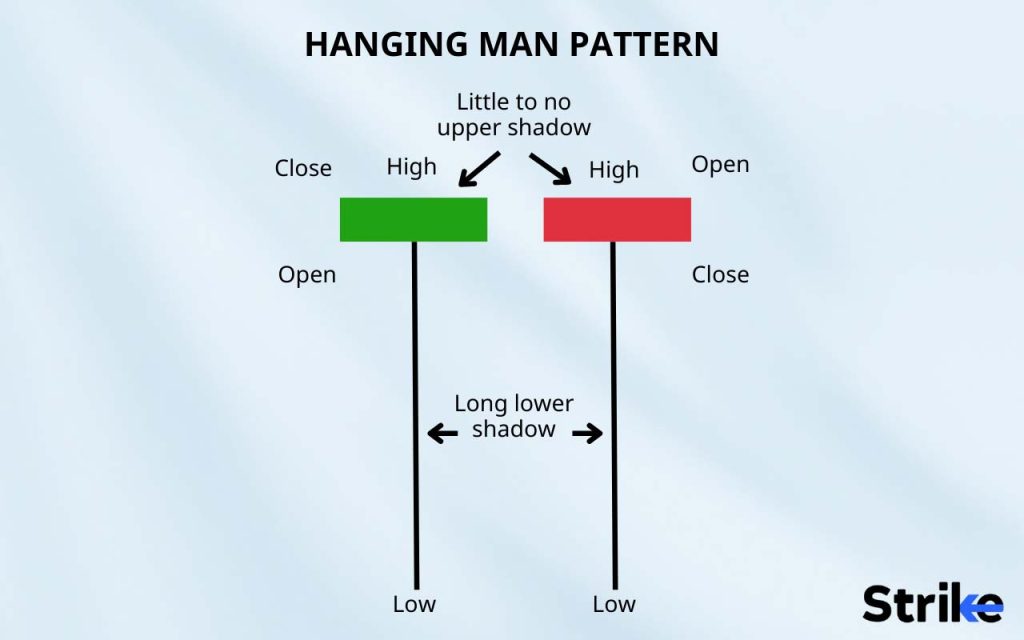
The Hanging Man pattern is used by traders to identify potential changes in market sentiment and make informed trade decisions. The pattern appearing after a long uptrend indicates that buying pressure is waning and the bears are gaining control.
How is a Hanging Man Candlestick Pattern structured?
The Hanging Man candlestick pattern has a small real body, a long lower shadow, and little to no upper shadow. The small real body is usually near the candle’s top and can be bullish or bearish. The low of the day is represented by the long lower shadow, which is at least twice the length of the real body, indicating that prices fell significantly during the day. Buyers
were able to push prices back up near the opening price, forming a small real body resembling a hanging man.
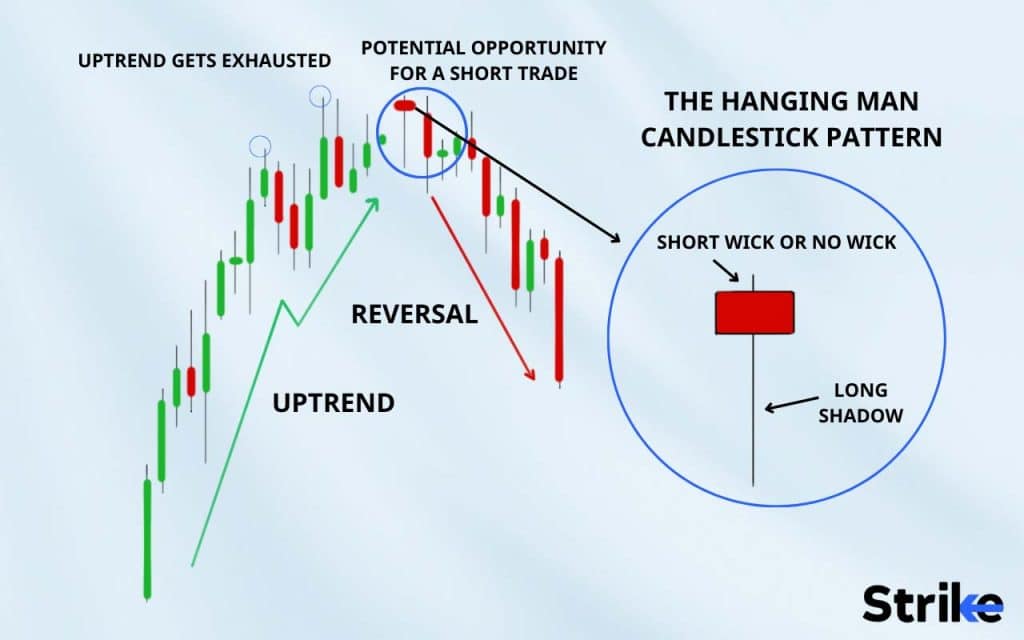
Traders look for a candlestick with a small real body near the top of the candle, a long lower shadow at least twice the length of the real body, and little to no upper shadow to identify a Hanging Man candlestick pattern. The pattern is typically found at the top of an uptrend and can indicate a potential downtrend reversal.
Does the colour of Hanging Man matter?
No, the colour is not the most important factor in recognising the pattern while the colour of the Hanging Man candlestick can provide traders with additional information. The candlestick’s structure and position are far more important in determining whether it represents a valid Hanging Man pattern.
But it may provide additional confirmation of a potential trend reversal if the Hanging Man pattern is coloured bearishly (red). However, traders should not make decisions based solely on the colour of the candlestick and should always confirm the pattern with additional technical analysis tools and indicators.
When does the Hanging Man Candlestick Pattern appear?
The Hanging Man candlestick pattern typically appears at the top of an uptrend and can indicate a potential downtrend reversal. It may also emerge following a period of market indecision or consolidation. The pattern is a bearish signal, indicating that the bulls are losing control and that the bears may take control. Traders frequently use the Hanging Man pattern as a signal to sell or go short in the market. Take a look at the graph below.
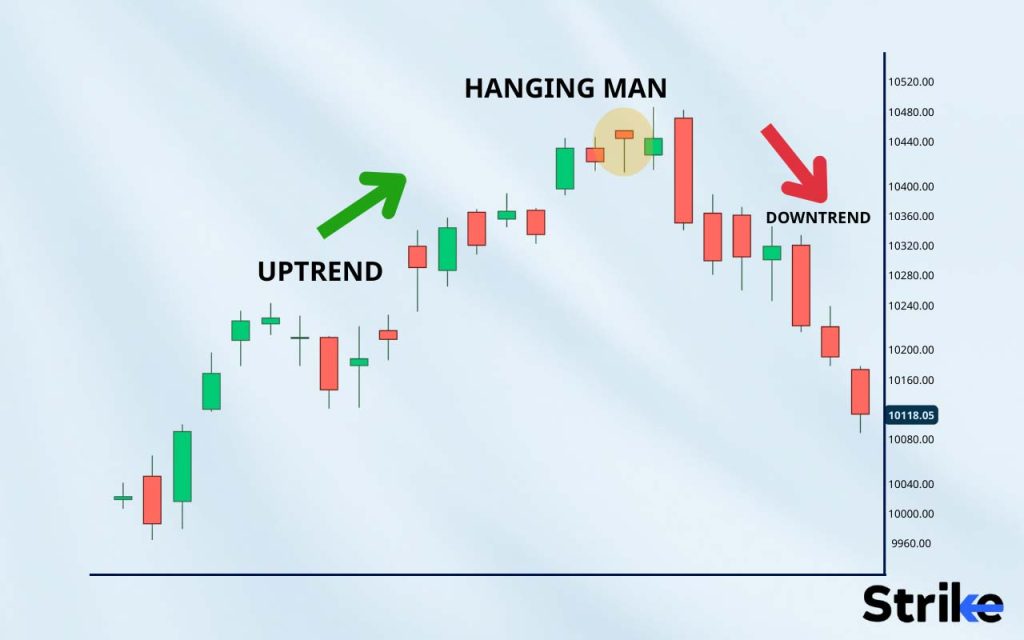
Here it is visible that the stock was in a trending position and then the hanging man candlestick pattern appeared. The stock turned bearish right after. Traders may use this information here to either exit their positions or to short a stock.
How frequently does the Hanging Man Candlestick Pattern occur?
The frequency with which the Hanging Man candlestick pattern appears will be determined by market scenarios and the time frame under consideration. The trend is not as common as some other candlestick patterns, but it can still occur on a regular basis.
How to identify Hanging Man Candlestick Pattern in Technical Analysis?
The Hanging Man has a long lower shadow, a small real body, and little or no upper shadow to characterise the pattern. The small real body, which is usually found at the top of the candlestick, can be bullish or bearish. Traders looking for the Hanging Man pattern should look for a candlestick with certain characteristics.
The candlestick should have a long lower shadow that is at least twice as long as the actual body. The upper shadow should be minimal or non-existent, indicating that the price did not trade higher than the real body. The real body should be small, indicating that price movement was minimal during the trading session. The real body of the candlestick should be at the top, indicating that the bulls were unable to push the price higher. Below is what an investor should see.
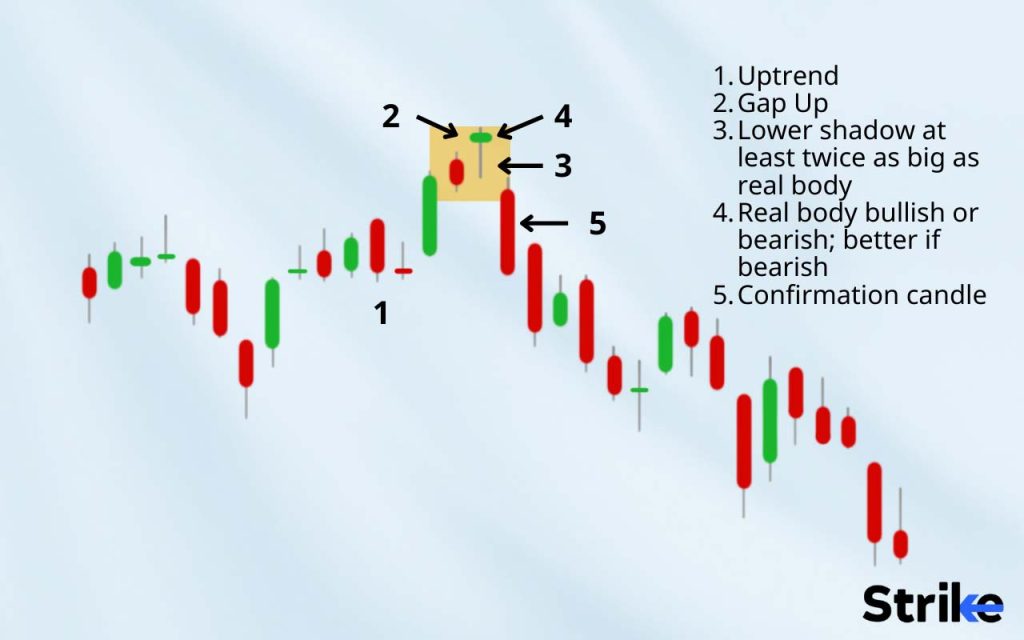
The pattern above has below characters that helps confirm.
- Smaller upper shadow
- Smaller body
- The body closer to the top of the wick
- Longer tail
Traders should seek confirmation from other technical analysis tools and indicators before making any trading decisions. Traders, for example, may look for a bearish divergence between the price and a momentum indicator, such as the Relative Strength Index (RSI). They may also look for a break below a critical support level to confirm the reversal.
What is the accuracy rate of the Hanging Man Candlestick Pattern in Technical Analysis?
It is difficult to provide a specific accuracy rate for the Hanging Man candlestick pattern because the accuracy will depend on several factors such as market conditions, time frame, and other technical indicators used in conjunction with the pattern.
The Hanging Man pattern can be useful in identifying potential market reversals. Traders should, however, not rely solely on this pattern and should use additional tools and indicators to confirm the pattern and make trading decisions.
How reliable is a Hanging Man Candlestick Pattern in Technical Analysis?
The reliability of the Hanging Man candlestick pattern in technical analysis can vary depending on the market conditions, time frame, and other technical indicators used in conjunction with the pattern.
What is the Success Rate of the Hanging Man Candlestick Pattern?
It is difficult to provide a specific success rate for the Hanging Man candlestick pattern because the accuracy will depend on several factors such as market conditions, time frame, and other technical indicators used in conjunction with the pattern. But technical analysts regard the Hanging Man pattern as a reliable tool for identifying potential market reversals.
How to Trade with Hanging Man Candlestick Pattern in Stock Market?
The below-listed steps will walk you through the steps to identify and confirm the Hanging Man pattern and how to use it to place a trade.
- Finding the pattern: Look for a candlestick with a small real body and a long lower shadow that resembles a “hanging man” with dangling legs. This pattern is common at the end of an uptrend.
- Confirm the trend: Use other technical indicators such as volume, trend lines, and moving averages to confirm the pattern. This will help to confirm the Hanging Man pattern’s potential reversal signal.
- Placing a trade: You can place your trade at this point. You can either exit your positions to avoid losses or enter a short position. The trade should be in the opposite direction of the current trend because the Hanging Man pattern indicates a potential reversal,
Remember to always use risk management strategies such as stop-loss and monitor your trades to protect your capital and maximize your profits in stock market.
When is the best time to Trade using Hanging Man Candlestick Pattern?
The best time to trade using the Hanging Man candlestick pattern is when it appears at the end of an uptrend, indicating a potential reversal in the market. Traders can employ strategies such as shorting at this point. It is best to avoid the pattern if the volume is low. Traders should also confirm the trend using another indicator.
What is an example of a Hanging Man Candlestick Pattern used in Trading?
Here is an example of trading with a hanging man candlestick pattern. Take a look at the picture below.
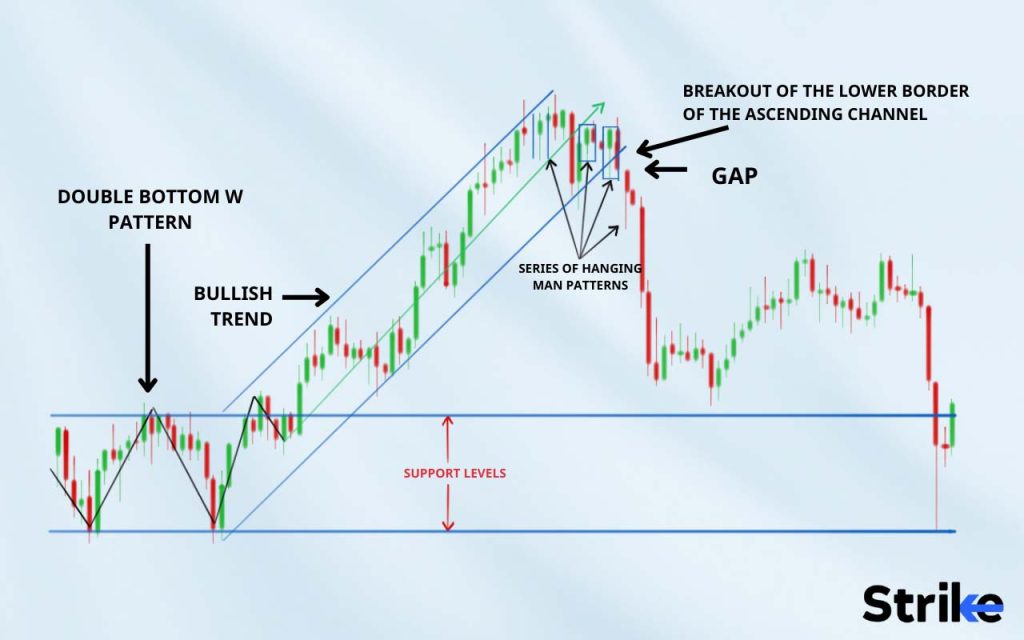
Here you can see that the market is slightly bullish. But then the hanging man pattern appears. The appearance of these patterns suggests trend reversal. Here the trend is bullish and the pattern suggests it turning bearish. You can see in the graph that market turned slightly bearish right after.
Is it profitable using Hanging Man Candlestick Pattern?
Yes, it is profitable to use a hanging man candlestick pattern if the trend is correctly identified. But there is no 100% assurance with any technical indicator, including hanging man. Using hanging man along with other indicators to confirm the trend is hence recommended.
Is a Hanging Man Candlestick Pattern a Bullish Reversal?
No, A Hanging Man candlestick pattern is generally considered a bearish reversal pattern, not a bullish one. It typically forms at the end of an uptrend and signals a potential trend reversal to the downside.
What Benefits Can a Hanging Man Candlestick Offer?
The main benefit of the hanging man candlestick pattern is simplicity and clarity. Below listed are some more benefits.
- It can provide an early sign for trend reversal
The hanging man is one of the few indicators that give traders an early warning sign of a trend reversal to bearish. This helps traders avoid losses and strategise accordingly.
- It helps traders identify entry and exit points
The hanging man pattern provides insights into possible support and resistance levels. This helps traders easily identify entry and exit points, especially when used in conjunction with other technical indicators.
- It is universal
The Hanging Man pattern can be used in a variety of financial markets, including stocks, forex, and commodities, making it a versatile tool for traders.
The hanging man is most beneficial when a trend is confirmed using another tool. Make sure you use it with a volume-confirming tool during highly volatile periods.
What are a Hanging Man Candlestick’s Drawbacks?
Hanging man candlestick patterns have some drawbacks to look out for to ensure the best results. Below listed are four main drawbacks.
- It often produces false signals
Hanging man is notorious for sometimes producing false trading signals. Hanging man can occur without any result on the price. Acting on these signals can result in a loss.
- It is unilateral
The hanging man gives limited information to the traders. It has to be used with a trend confirmation tool all the time for accuracy.
- It often gets overanalyzed
Hanging man often gets overanalyzed because the information is limited for the traders.
- It doesn’t work on volatile markets
Hanging man is often unusable when the markers are volatile. The patterns formed may not signal anything at such a time.
Most of the disadvantages of hanging man may be overcome by using a trend-confirming tool or another technical indicator.
What are other Types of Candlestick besides Hanging Man?
The hanging man is just one of the candlestick patterns traders observe to help them trade. Below listed are five other types of candlestick patterns besides hanging man.
- Doji
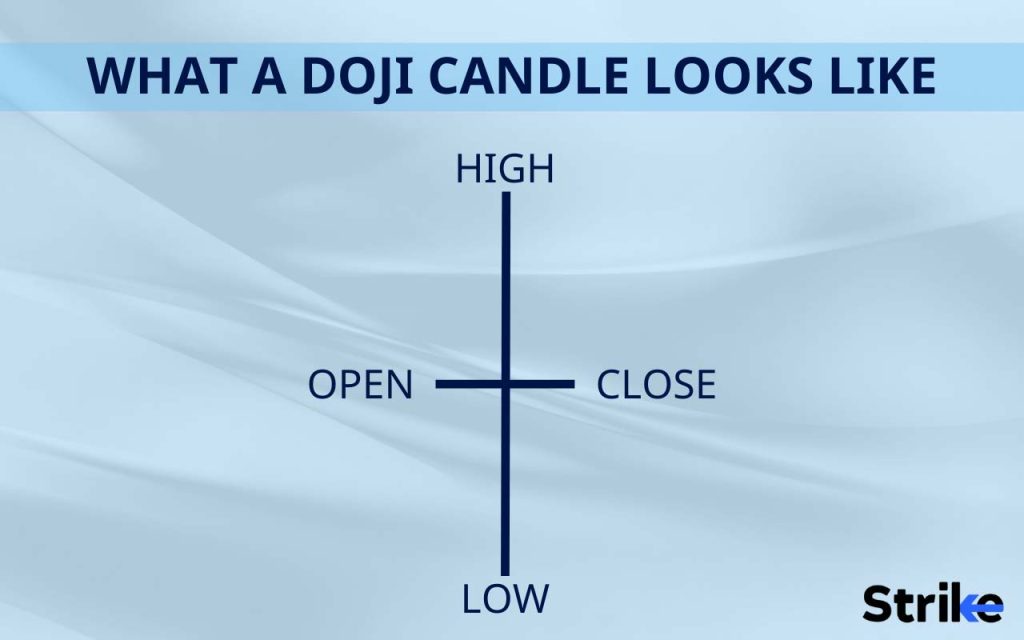
Doji is a single candlestick pattern distinguished by its distinctive shape, which resembles a cross or plus sign. The Doji pattern forms, resulting in a small or non-existent body and long upper and lower shadows when an asset’s opening and closing prices are nearly identical.
Doji patterns come in a variety of shapes and sizes, including the standard Doji, long-legged Doji, dragonfly Doji, gravestone Doji, and four-price Doji. Each type of Doji pattern has its own distinct characteristics and can provide useful information about market sentiment and price action.
The Doji pattern is commonly interpreted as a sign of market indecision, implying that buyers and sellers are evenly matched and unable to establish a clear direction. Depending on the context, it can indicate a potential reversal or trend continuation.
- Dragonfly doji
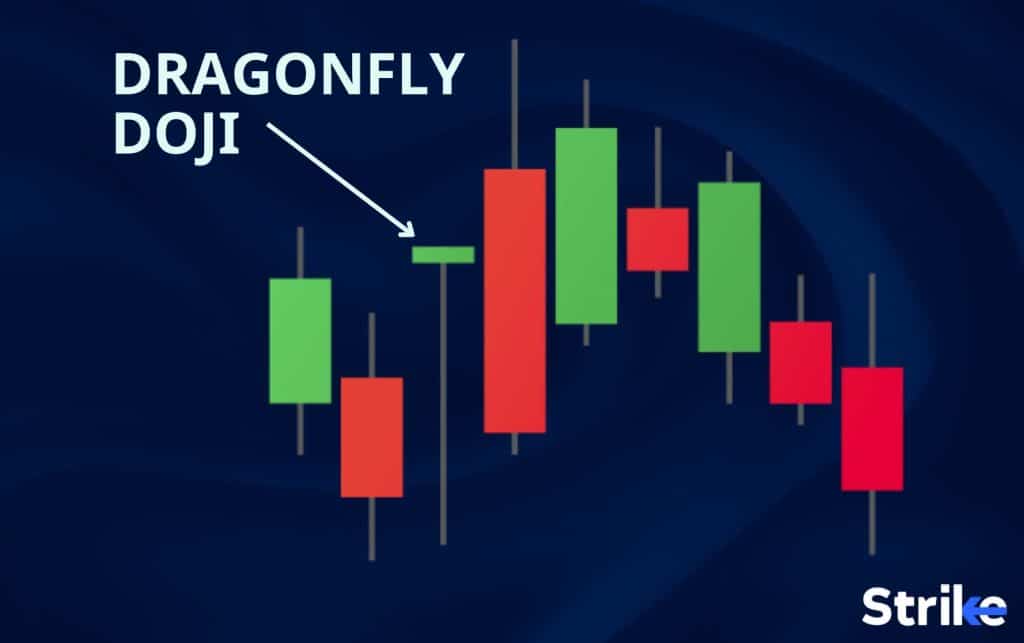
The Dragonfly Doji candlestick pattern is a type of Doji candlestick pattern that can provide useful information about market sentiment and price action. It is distinguished by a long lower shadow, a small or non-existent body, and little to no upper shadow, similar to that of a dragonfly. The Dragonfly Doji pattern typically appears at the bottom of a downtrend, indicating that sellers’ momentum has waned and buyers are gaining control of the market. Depending on the context, it can also indicate a potential trend reversal or continuation.
- The spinning top

A Spinning Top candlestick pattern is a type of candlestick pattern that can reveal market sentiment and price movement. It appears when an asset’s opening and closing prices are close to each other, resulting in a small body and upper and lower shadows that are longer than the body. The Spinning Top pattern indicates that buyers and sellers are nearly evenly matched and that neither group can establish a clear market direction. Depending on the context, this can indicate a potential shift in market sentiment as well as a trend reversal or continuation.
- The Hammer

The Hammer pattern is a type of candlestick pattern that can reveal important information about market sentiment and price action. It is distinguished by a long lower shadow, a small or non-existent upper shadow, and a small body resembling a hammer at the top of the candle. The Hammer pattern is most commonly seen at the bottom of a downtrend, indicating that sellers have lost momentum and buyers are gaining control of the market.
- Bearish engulfing

A Bearish Engulfing Pattern is a candlestick pattern that appears on a price chart and indicates the potential reversal of an uptrend. It is formed by two candles, the first of which is a bullish candle and the second of which is a bearish candle that engulfs the first. The first candle should have a small body, indicating a narrow price range between the open and close, and a long lower shadow, indicating that buyers drove the price higher during the trading session. The second candle, on the other hand, should have a long body, indicating a wide price range between open and close, and should completely engulf the first candle’s body, closing below its opening price.
The types of candlesticks patterns provide insights into trends and trend reversal. Using it alongside technical and fundamental analysis helps traders in their trades.
Is There a Similarity Between a Hanging Man Candlestick and A Shooting Star Candlestick?
Yes, both the Hanging Man candlestick and the Shooting Star candlestick are reversal patterns in a price chart that indicate a potential trend reversal. The Hanging Man and Shooting Star candlesticks are similar in appearance, with a small body at the top of the candle, a long lower shadow, and little or no upper shadow. The main distinction between the two patterns is their position in the chart. Below is a picture comparison of both.
What is the difference between a Hanging Man Candlestick and a Hammer Candlestick?
The Hanging Man and Hammer candlesticks are both key reversal patterns in technical analysis, but their implications for price action are diametrically opposed. The main difference between the two patterns is where they appear on the price chart and what they mean for market mood.
The Hanging Man pattern shows as a small-bodied candle with a long lower shadow and little or no upper shadow. It signals that buyers are losing steam and that sellers are gaining control of the market. The extended lower shadow suggests that throughout the trading session, sellers pushed the price down, but buyers were able to drive it back up, resulting in a small body.
The Hammer pattern emerges after a downtrend and resembles a small-bodied candle with a long lower shadow and little or no upper shadow. It signals that buyers are gaining control of the market while sellers are losing steam. The extended lower shadow suggests that throughout the trading session, sellers pushed the price down, but buyers were able to drive it back up, resulting in a small body. Below is how a hammer pattern looks like.




![85 Common Stock Market Terminologies for Dummies [Updated List for 2026] 124 85 Common Stock Market Terminologies for Dummies [Updated List for 2025]](https://www.strike.money/wp-content/uploads/2025/04/Popular-Stock-Market-Terms-for-Beginners-Banner.png)










No Comments Yet.